HUB0000 User Guide: Difference between revisions
No edit summary |
|||
| Line 3: | Line 3: | ||
<metadesc>The core of our product line, the USB VINT Hub has 6 VINT ports allowing for endless possibilities for USB sensing and control.</metadesc> | <metadesc>The core of our product line, the USB VINT Hub has 6 VINT ports allowing for endless possibilities for USB sensing and control.</metadesc> | ||
[[Category:UserGuide]] | [[Category:UserGuide]] | ||
== | ==Part 1: Setup== | ||
Before you get started with plugging in and setting up your VINT Hub, we recommend downloading our libraries from [[Operating_System_Support|here]]. | Before you get started with plugging in and setting up your VINT Hub, we recommend downloading our libraries from [[Operating_System_Support|here]]. | ||
{{UGcontrolpanel|HUB0000}} | {{UGcontrolpanel|HUB0000}} | ||
==Using | == Part 2: Using Your Phidget == | ||
===About=== | |||
The VINT Hub provides a stable interface to connect your devices to your computer via USB. The VINT Hub has 6 ports. Each port can: | |||
* Connect to a VINT Device | |||
* Read a 0-5V Voltage or ratiometric sensor (connect to Analog Input sensors) | |||
* Act as a digital output (control LEDs, relays, digital circuits, and other simple electronics) | |||
* Act as a digital input (read the state of a switch) | |||
===Explore Your Phidget Channels Using the Control Panel=== | |||
[[Image: | [[Image:HUB0000-panel.jpg|link=|center]] | ||
The VINT Hub is a connecting point between your computer and device allowing for simple communication. You can use your Control Panel to view your attached Phidgets. Explore the 5 types of connections bellow: | |||
{{UGC-Start}} | |||
{{UGC-Entry|Intelligent VINT Devices| | |||
| | | | ||
[[Image:vint-v.jpg|350px|link=]] | |||
[[Image:vint- | |||
VINT Devices like the TMP1101 or DCC1003 are Phidgets that digitally communicate with the VINT Hub. Each device will have unique features, so it is recommended you visit the individual product page for more details. | |||
When attached correctly these Phidgets will appear by name in your Control Panel, with each channel listed below the name. For example, when the HUM1000 is attached you will see: | |||
[[Image: | [[Image:HUM1000_Panel.jpg|link=|center]] | ||
}} | |||
{{UGC-Entry|Digital Input:| read the state of a switch | |||
| | | | ||
[[ | [[Image:vint-di.jpg|350px|link=]] | ||
'''Digital Input''' is one of the VINT Hub’s built-in Channel Classes. Any of the these ports can act as an active-low digital input, making them useful for reading switches and buttons. The above image provides an example of how to wire a switch to be used with the VINT Hub. | |||
If you open '''Digital Input Mode''' in the Control Panel you will be able to see the state of your button/switch. | |||
[[Image:HUB0000-di.jpg|link=]] | |||
}} | |||
{{UGC-Entry| Digital Output:| control LEDs, relays, digital circuits, and other simple electronics | |||
{ | |||
| | |||
| | | | ||
[[Image:vint-do.jpg|350px|link=]] | |||
[[Image: | |||
'''Digital Output''' is one of the VINT Hub’s built-in Channel Classes. Any of these ports can be used as a 3.3V digital output, making them useful for blinking LEDs. The above image demonstrates how to connect your LED to be used with the VINT Hub. | |||
Open '''Digital Output Mode''' in the Control Panel to control the 3.3V output. | |||
[[Image:HUB0000-do.jpg|850px|link=]] | |||
}} | |||
{ | {{UGC-Entry| Voltage Input:| Non-ratiometric Analog sensors and monitoring 5V digital circuits | ||
| | |||
| | | | ||
[[Image:vint-vi.jpg|350px|link=]] | |||
[[Image:vint- | |||
'''Voltage Input''' is one of the VINT Hub’s built-in Channel Classes. Any of these ports can be used to read voltage, making them great for reading non-ratiometric sensors and monitoring 5V digital circuits. | |||
Open '''Voltage Input Mode''' in the Control Panel to view your device’s output voltage. | |||
[[Image:HUB0000-vi.jpg|850px|link=]] | |||
}} | |||
{ | {{UGC-Entry| Voltage Ratio Input:| Analog ratiometric sensors | ||
| | |||
| | | | ||
[[Image:vint-vr.jpg|350px|link=]] | |||
'''Voltage Ratio Input''' is one of the VINT Hub’s built-in Channel Classes. Any of these ports can act as a Voltage Ratio Input comparing the voltage provided to the voltage returned by the device, making it useful for connecting ratiometric sensors. The voltage ratio is reported in Volts per Volt. For example, if the Phidget is providing 5V and the sensor is sending back 2.5V, the ratio will be 0.5V/V. | |||
Open '''Voltage Ratio Input Mode''' in the Control Panel to view your device’s voltage ratio. | |||
[[Image:HUB0000-vr.jpg|850px|link=]] | |||
}} | |||
{{ | {{UGC-End}} | ||
{{UG-Part3}} | |||
== Part 4: Advanced Topics and Troubleshooting == | |||
{ | {{UGC-Start}} | ||
| | {{UGC-Addressing}} | ||
{{UGC-DataInterval}} | |||
{{UGC-Entry|VINT Ports| | |||
| | | | ||
For more information on the capabilities of the ports on the VINT Hub, see the [[What_is_VINT%3F|VINT Primer]].}} | |||
{{UGC-Entry|Setting the Device Label| | |||
{ | |||
| | |||
| | | | ||
When opening channels with Phidgets, you can set several properties to make sure you are accessing the precise channel you want. The HUB0000 has a unique serial number that can be used to find its ports or any VINT devices connected to them. If you want something more customizable and human-readable, you can use the [[Addressing_Phidgets#Label|device label]] instead. You can customize the device label by using {{code|writeDeviceLabel}} on the {{code|Hub}} object after it has been opened. | |||
With the device label, you can address any of the VINT Hub's channels, or any connected VINT device channels. The device label will remain after the VINT Hub is unplugged as it is stored in flash memory.}} | |||
{{ | {{UGC-End}} | ||
Revision as of 18:28, 21 April 2020
Part 1: Setup
Before you get started with plugging in and setting up your VINT Hub, we recommend downloading our libraries from here.
Phidget Control Panel
In order to demonstrate the functionality of the HUB0000, the Phidget Control Panel running on a Windows machine will be used.
The Phidget Control Panel is available for use on both macOS and Windows machines.
Windows
To open the Phidget Control Panel on Windows, find the ![]() icon in the taskbar. If it is not there, open up the start menu and search for Phidget Control Panel
icon in the taskbar. If it is not there, open up the start menu and search for Phidget Control Panel
macOS
To open the Phidget Control Panel on macOS, open Finder and navigate to the Phidget Control Panel in the Applications list. Double click on the ![]() icon to bring up the Phidget Control Panel.
icon to bring up the Phidget Control Panel.
For more information, take a look at the getting started guide for your operating system:
Linux users can follow the getting started with Linux guide and continue reading here for more information about the HUB0000.
First Look
After plugging the HUB0000 into your computer and opening the Phidget Control Panel, you will see something like this:
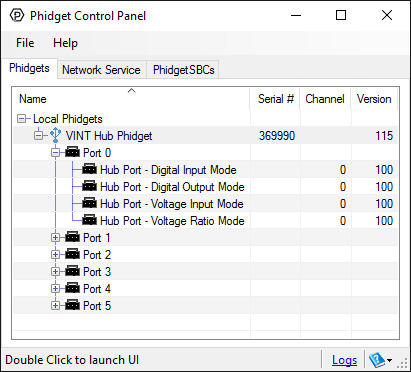
The Phidget Control Panel will list all connected Phidgets and associated objects, as well as the following information:
- Serial number: allows you to differentiate between similar Phidgets.
- Channel: allows you to differentiate between similar objects on a Phidget.
- Version number: corresponds to the firmware version your Phidget is running. If your Phidget is listed in red, your firmware is out of date. Update the firmware by double-clicking the entry.
The Phidget Control Panel can also be used to test your device. Double-clicking on an object will open an example.
Part 2: Using Your Phidget
About
The VINT Hub provides a stable interface to connect your devices to your computer via USB. The VINT Hub has 6 ports. Each port can:
- Connect to a VINT Device
- Read a 0-5V Voltage or ratiometric sensor (connect to Analog Input sensors)
- Act as a digital output (control LEDs, relays, digital circuits, and other simple electronics)
- Act as a digital input (read the state of a switch)
Explore Your Phidget Channels Using the Control Panel
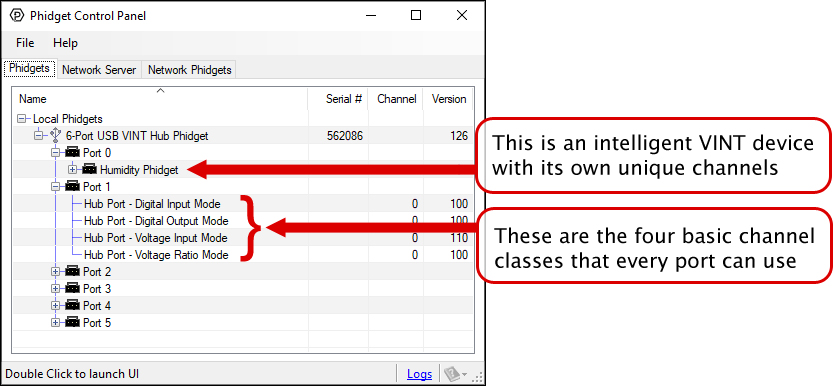
The VINT Hub is a connecting point between your computer and device allowing for simple communication. You can use your Control Panel to view your attached Phidgets. Explore the 5 types of connections bellow:
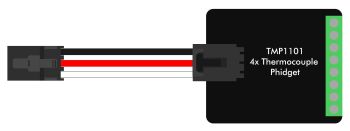
VINT Devices like the TMP1101 or DCC1003 are Phidgets that digitally communicate with the VINT Hub. Each device will have unique features, so it is recommended you visit the individual product page for more details.
When attached correctly these Phidgets will appear by name in your Control Panel, with each channel listed below the name. For example, when the HUM1000 is attached you will see:
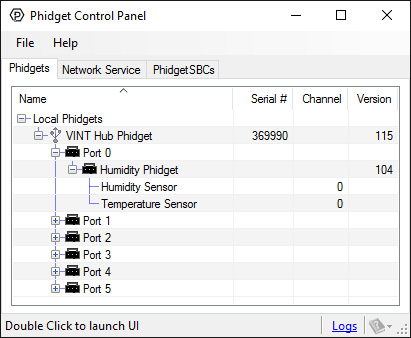
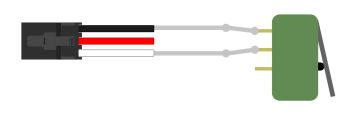
Digital Input is one of the VINT Hub’s built-in Channel Classes. Any of the these ports can act as an active-low digital input, making them useful for reading switches and buttons. The above image provides an example of how to wire a switch to be used with the VINT Hub.
If you open Digital Input Mode in the Control Panel you will be able to see the state of your button/switch.
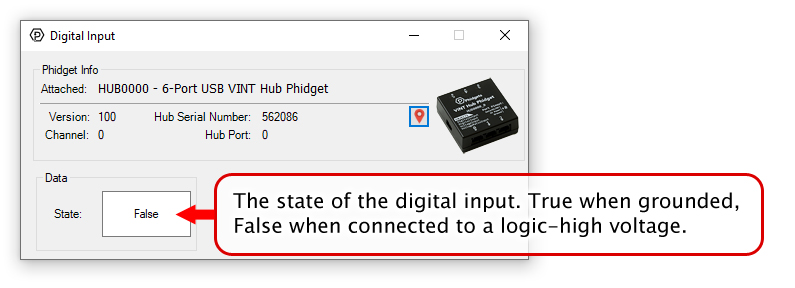

Digital Output is one of the VINT Hub’s built-in Channel Classes. Any of these ports can be used as a 3.3V digital output, making them useful for blinking LEDs. The above image demonstrates how to connect your LED to be used with the VINT Hub.
Open Digital Output Mode in the Control Panel to control the 3.3V output.
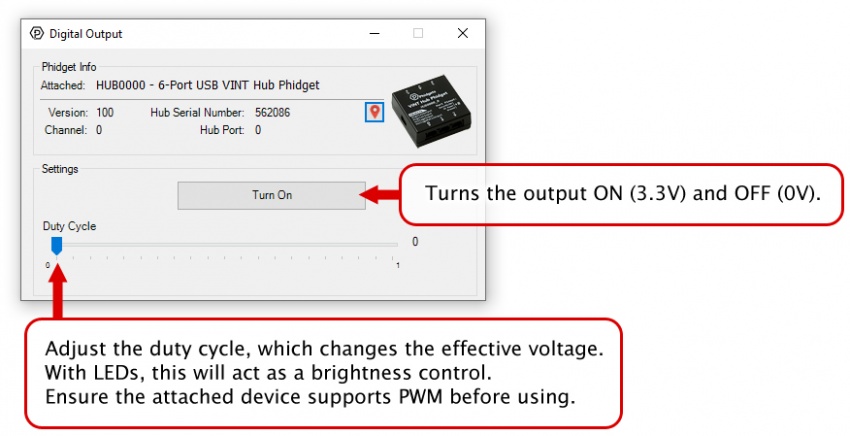

Voltage Input is one of the VINT Hub’s built-in Channel Classes. Any of these ports can be used to read voltage, making them great for reading non-ratiometric sensors and monitoring 5V digital circuits.
Open Voltage Input Mode in the Control Panel to view your device’s output voltage.
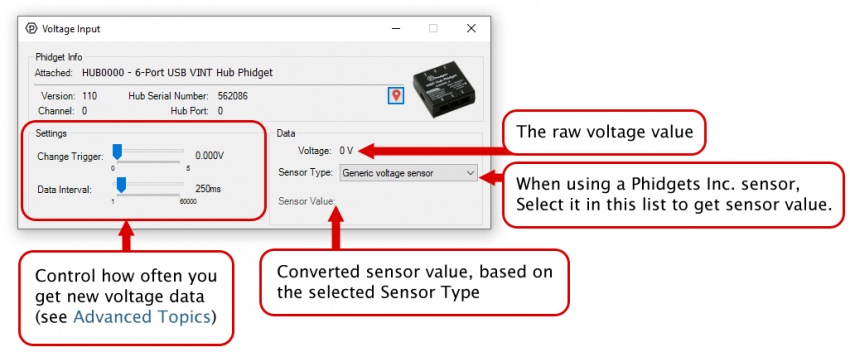
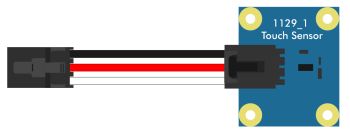
Voltage Ratio Input is one of the VINT Hub’s built-in Channel Classes. Any of these ports can act as a Voltage Ratio Input comparing the voltage provided to the voltage returned by the device, making it useful for connecting ratiometric sensors. The voltage ratio is reported in Volts per Volt. For example, if the Phidget is providing 5V and the sensor is sending back 2.5V, the ratio will be 0.5V/V.
Open Voltage Ratio Input Mode in the Control Panel to view your device’s voltage ratio.
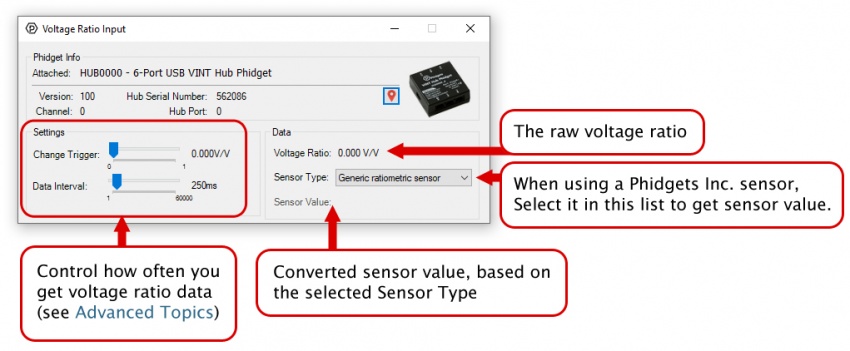
Part 3: Create your Program
Part 4: Advanced Topics and Troubleshooting
Before you open a Phidget channel in your program, you can set these properties to specify which channel to open. You can find this information through the Control Panel.
1. Open the Control Panel and double-click on the red map pin icon:

2. The Addressing Information window will open. Here you will find all the information you need to address your Phidget in your program.

See the Phidget22 API for your language to determine exact syntax for each property.
The Change Trigger is the minimum change in the sensor data needed to trigger a new data event.
The Data Interval is the time (in ms) between data events sent out from your Phidget.
The Data Rate is the reciprocal of Data Interval (measured in Hz), and setting it will set the reciprocal value for Data Interval and vice-versa.
You can modify one or both of these values to achieve different data outputs. You can learn more about these properties here.
For more information on the capabilities of the ports on the VINT Hub, see the VINT Primer.
When opening channels with Phidgets, you can set several properties to make sure you are accessing the precise channel you want. The HUB0000 has a unique serial number that can be used to find its ports or any VINT devices connected to them. If you want something more customizable and human-readable, you can use the device label instead. You can customize the device label by using writeDeviceLabel on the Hub object after it has been opened.
With the device label, you can address any of the VINT Hub's channels, or any connected VINT device channels. The device label will remain after the VINT Hub is unplugged as it is stored in flash memory.
